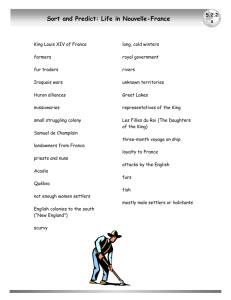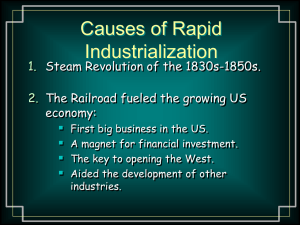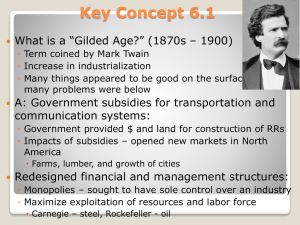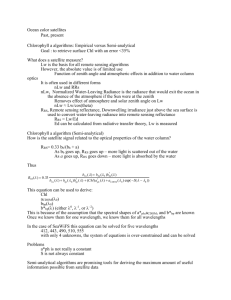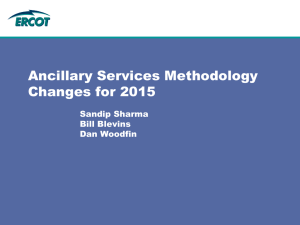Chapter 5 Part 3 - Grosse Pointe Public School System
advertisement
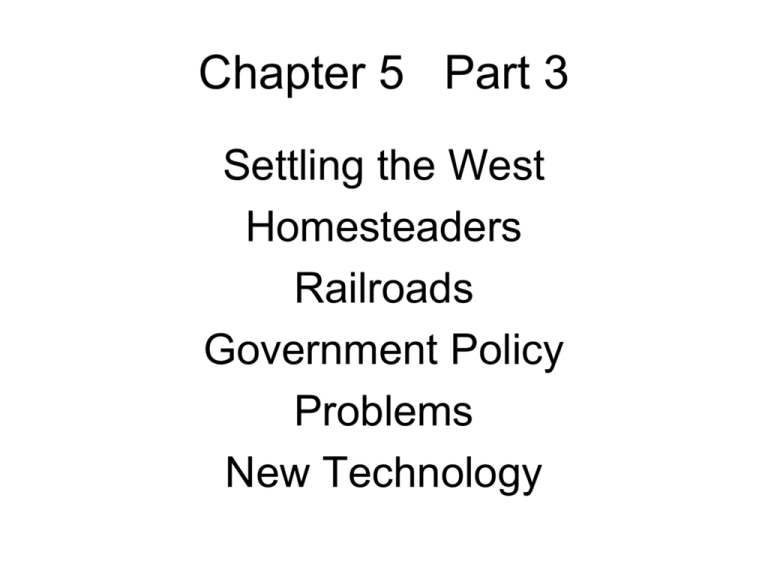
Chapter 5 Part 3 Settling the West Homesteaders Railroads Government Policy Problems New Technology Took 250 Years • For Europeans and Americans to settle up to the Mississippi River • Took only 30 years to settle to the Pacific • Due to Railroads and Government land and Indian policy Railroads • The government wanted to connect up the country with the railroad • Encouraged RR companies with 170 million acres of free land • And with ½ Billion Dollars! The Pacific Railway Act • In 1850 set the precedent for giving land grants to railroads • Fear that the RRs would just turn around and resell the land so… • Land was given in narrow strips in a checkerboard patten next to other narrow strips of government land RRs were given • 5 square miles of land per mile of track laid • Most given to the largest RR companies: • The Union Pacific and the Central Pacific were among them The Trannscontinental RR • Central Pacific built from Sacramento, Ca. to the East • Union Pacific went from Omaha, Neraska to the West • They met in 1869 in Promontary Point, Utah Within 15 Years • There were 5 transcontinental RRs RRs were built by • • • • Chinese immigrants Irish Mexicans Native Americans • The Anson-Burlingame Treaty (1868) with China. To speed up the Chinese immigration! Government Policy • Land Acts: • The Homestead Acr (1862) gave 160 acres of free land to American citizens or porspective American citizens • ONLY 160 acres! The Homestead Act • Over 600,000 folks took advantage of the Homestead Act • But Fraud by Lumber companies and land speculators and RRs • Only 10% ended up with settlers Other Land Acts for Settlers • The Timber Culture Act • The Timber and Stone Act • The Desert Land Act • In Oklahoma so many came before the government was able to sell so it is called the Sooner State The Morrill Act 1862 • Gave federal land within a state to the states • States could sell this land to establish Land Grant Institutions (Agricultural Colleges)…like MSU 1887 The Hatch Act • Provided federal funds to establish agricultural experimental stations • Fertilizers • Irrigation techniques Protecting the Wilderness • 1870 Henry Washburn and Nathaniel Langford petitioned the government for protection of parts of the wilderness • By 1872 Yellowstone National Park was established • Some RRs were forced to return some land 1893 The Turner Thesis • By Frederick Jackson Turner • Aka “The Significance of the Frontier on American History” • Suggested that Democracy would never get old and stale like European governments Because we had to reinvent democracy every time we pushed through the frontier…a myth Hardships for Plains Settlers • • • • • • • • Draught Fire Floods Blizzards Locusts Native Americans (still some) Outlaws Insanity Population Growth on the Plains • 1850 Only 1% of the population • By 1900 30% • Exodusters: Black settlers in the West Dugouts and Soddies • There were no trees to build with! • Settlers dug into ravines and sides of hills and lived inside • Some cut and layered thick sod to make houses…a soddy Soddies and Dugouts • WERE warm in the Winter and cool in the summer and fireproof BUT • They were small, dark leaked and lots of critters lived there too! Women • Plowed, P;anted and harvested with husbands • They sheared sheep, carded wool and put up fruit and vegetables for the winter • They hauled water, made the family clothing, soap, candles • Active in Church and schools New Inventions • • • • • • • 1837 1847 1869 1841 1874 1878 1878 John Deere’s Steel Plow McCormick’s Reaper The Spring-tooth Harow The grain drill Barbed Wire The Corn binder Improved Reaper More produced in less time! • 1830 One bushel of grain took 183 minutes to produce • By 1900 One bushel of grain took 10 minutes to produce OVERPRODUCTION • • • • Wolrd wide Caused falling prices for farm goods Farmers tried to produce more Caused more overproduction! • Land value declined • Many lost their farms Bonanza Farms • Huge commercial farms • One-crop farming • Not as flexible as smaller farms • Drought, etc. caused many to fail Other Farming Problems • High transportation costs (RRs) • Farm machinery expensive • Most land mortgaged and interest rates were high • In the South’’’the Crop Lien System

